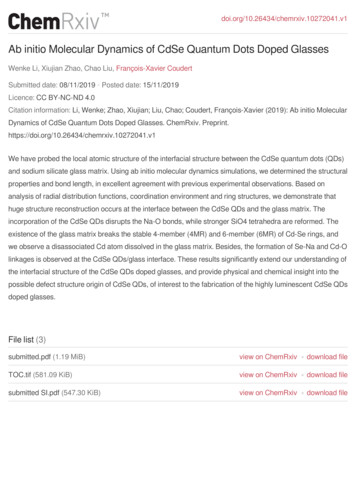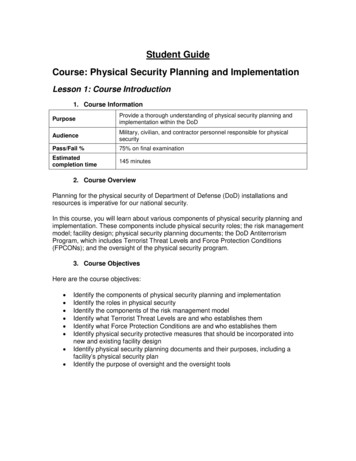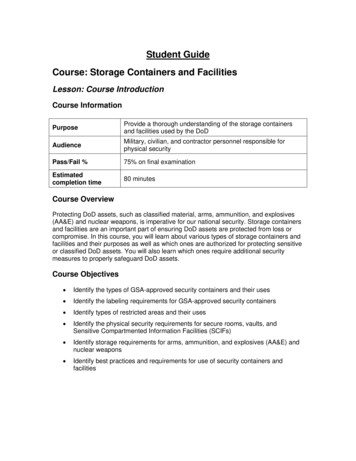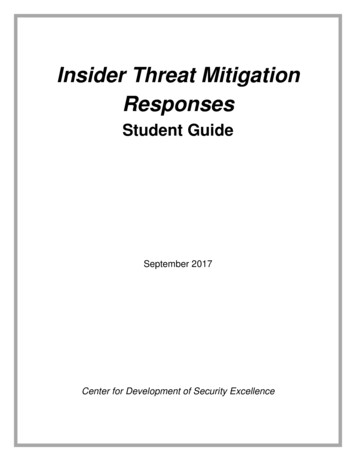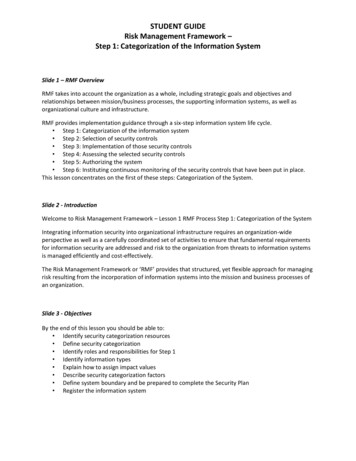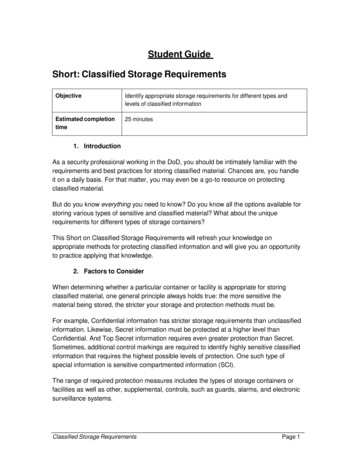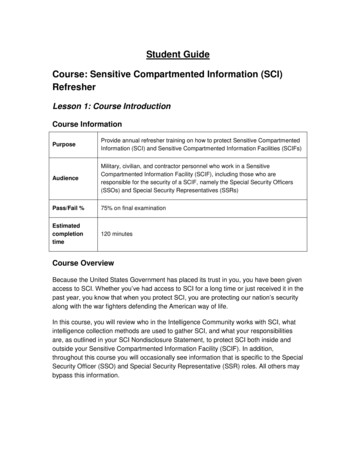
Transcription
Student GuideCourse: Sensitive Compartmented Information (SCI)RefresherLesson 1: Course IntroductionCourse InformationPurposeProvide annual refresher training on how to protect Sensitive CompartmentedInformation (SCI) and Sensitive Compartmented Information Facilities (SCIFs)AudienceMilitary, civilian, and contractor personnel who work in a SensitiveCompartmented Information Facility (SCIF), including those who areresponsible for the security of a SCIF, namely the Special Security Officers(SSOs) and Special Security Representatives (SSRs)Pass/Fail %75% on final examinationEstimatedcompletiontime120 minutesCourse OverviewBecause the United States Government has placed its trust in you, you have been givenaccess to SCI. Whether you’ve had access to SCI for a long time or just received it in thepast year, you know that when you protect SCI, you are protecting our nation’s securityalong with the war fighters defending the American way of life.In this course, you will review who in the Intelligence Community works with SCI, whatintelligence collection methods are used to gather SCI, and what your responsibilitiesare, as outlined in your SCI Nondisclosure Statement, to protect SCI both inside andoutside your Sensitive Compartmented Information Facility (SCIF). In addition,throughout this course you will occasionally see information that is specific to the SpecialSecurity Officer (SSO) and Special Security Representative (SSR) roles. All others maybypass this information.
Sensitive Compartmented Information (SCI) RefresherLesson 1: Course IntroductionStudent GuideCourse ObjectivesHere are the overall course objectives: Recognize SCI policy guidance documents Identify the purpose and components of the Sensitive CompartmentedInformation (SCI) Nondisclosure Statement (NdS) Identify classification markings and dissemination controls for SCI materials Identify the proper methods for handling, discussing, reproducing, transporting,and destroying SCI material Identify the proper procedures for visitors and escorts in a SCIF Identify the types of accredited SCIFs and their purposes Recognize the types of information that must be reported by or about individualswho have SCI accessHere are additional lesson objectives for SSOs/SSRs: Identify the process for SCI pre-screening and indoctrination Identify the SCIF accreditation process Identify the components of the Fixed Facility Checklist (FFC)Course StructureThis course is organized into the lessons listed here: Course Introduction SCI Fundamentals SCI Control Systems and Markings Protecting SCI SCI Reporting Requirements Course ConclusionPage 2
Student GuideCourse: Sensitive Compartmented Information (SCI)RefresherLesson 2: SCI FundamentalsLesson Introduction1. OpeningOur democratic principles require that the American people be informed of the activitiesof their Government. Also, our nation's progress depends on the free flow of information.Nevertheless, throughout our history, the national interest has required that certaininformation be maintained in confidence in order to protect our citizens, our democraticinstitutions, and our participation within the community of nations. Through the use ofcontrolled environments, classification, and compartmentation, we protect our assetsand our nation’s security from threats such as spies, insiders, terrorists, and foreignintelligence services. Your position exposes you to Sensitive CompartmentedInformation emanating from the Intelligence Community. SCI involves intelligencesources and methods that are the Intelligence Community’s most treasured secrets.Although the protection challenge is significant, it is your life-long security responsibilityand legal obligation to protect SCI.2. ObjectivesIn this lesson, you will review fundamental information about SCI such as the membersof the Intelligence Community (IC), SCI policy and guidance documents, and the SCINondisclosure Statement.Here are the lesson objectives: Recognize SCI policy and guidance documents Identify the purpose and components of the SCI Nondisclosure Agreement3. IC MembersAs you are aware, SCI is generated and regulated by various entities within the U.S.Intelligence Community (IC). The IC is headed by the Director of National Intelligence(DNI) and comprises the Central Intelligence Agency (CIA), which is an independentagency, as well as Departmental Intelligence Elements, which are government agencies,and Department of Defense (DoD) Intelligence Elements, which are the defenseagencies and military components.
Sensitive Compartmented Information (SCI) RefresherLesson 2: SCI FundamentalsStudent GuideThe DNI and the Defense Intelligence Agency (DIA) have direct authority over SensitiveCompartmented Information Facilities (SCIFs) in that the DNI establishes the securityrequirements for SCIFs and the DIA is responsible for the accreditation of DoD SCIFs.Head of ICDirector of National Intelligence (DNI)The Director of National Intelligence (DNI) hasoversight of the Intelligence Community (IC). The DNIoversees the priorities, targets, operations, andbudget execution of the IC. The DNI establishes thesecurity requirements for Sensitive CompartmentedInformation Facilities (SCIFs).Independent AgencyCentral Intelligence Agency (CIA)The Central Intelligence Agency (CIA) providesaccurate, evidence-based, comprehensive, and timelynational intelligence related to national security. TheCIA conducts counterintelligence activities, specialactivities, and other functions related to nationalintelligence and national security as directed by thePresident. The CIA collects Human Intelligence(HUMINT) through its clandestine arm, the NationalClandestine Service (NCS). The CIA also operatesthe Open Source Center (OSINT), which collectsintelligence from publicly available sources andanalyzes it to produce actionable intelligence.Departmental Intelligence ElementsDepartment of Energy (DOE)The Department of Energy’s Office of Intelligence andCounterintelligence performs analyses of foreignnuclear weapons, nuclear proliferation, and energysecurity-related intelligence issues in support of U.S.national security policies, programs, and objectives.Drug Enforcement Administration(DEA)The Drug Enforcement Administration’s Office ofNational Security Intelligence deals with the nexusbetween illegal drug production and trafficking and theworldwide terrorism threat.TreasuryThe Treasury Department’s Office of Intelligence andAnalysis collects and processes information that mayaffect U.S. fiscal and monetary policy.Page 2
Sensitive Compartmented Information (SCI) RefresherLesson 2: SCI FundamentalsStudent GuideDepartmental Intelligence ElementsDepartment of Homeland Security(DHS)The Department of Homeland Security (DHS) wasformed in response to the terrorist attack onSeptember 11, 2001. The DHS combined 22previously existing agencies into one in order toreduce the vulnerability of the U.S. to terrorism and todetect, prevent, and respond to terrorist attacks. TheDHS is composed of five directorates. The Intelligenceand Analysis Directorate is a member of the IC. Othernotable components of DHS involved in the IC includethe U.S. Coast Guard, the Secret Service, the FederalEmergency Management Agency (FEMA), CustomsBorder Patrol, and Immigration and CustomsEnforcement.Department of State (DOS)The Department of State’s Bureau of Intelligence andResearch deals with information affecting U.S. foreignpolicy.Federal Bureau of Investigation (FBI)The Federal Bureau of Investigation’s (FBI) mission isto protect and defend the U.S. against terrorist andforeign intelligence threats, to uphold and enforce thecriminal laws of the U.S., and to provide theleadership and criminal justice services to federal,state, municipal, and international agencies andpartners. The National Security Branch is the divisionof the FBI that focuses on intelligence and is amember of the IC.U.S. Coast Guard (USCG)The United States Coast Guard is a military, multimission, maritime service within the Department ofHomeland Security. The Coast Guard is one of thenation's five armed services. With maritime security asits North Star, core roles are protecting the public, theenvironment, and guarding U.S. economic andsecurity interests. It performs those missions in anymaritime region in which those interests may be atrisk, including America's ports, coastal waters,offshore regions, inland waterways, and internationalwaters. To assist in accomplishing the many diversemissions of the Coast Guard, senior leadership, andoperational commanders rely on the Coast GuardIntelligence and Criminal Investigations Program. TheCoast Guard became a member of the IntelligenceCommunity on 28 December 2001.Page 3
Sensitive Compartmented Information (SCI) RefresherLesson 2: SCI FundamentalsStudent GuideDoD Intelligence ElementsDefense Intelligence Agency (DIA)The Defense Intelligence Agency (DIA) coordinatesmilitary intelligence. The DIA is the DoD combatsupport agency and an important member of the U.S.IC. The DIA is a major producer and manager offoreign military intelligence. The DIA provides militaryintelligence to war fighters, defense policymakers, andforce planners in the DoD and IC, in support of U.S.military planning and operations and weapon systemacquisition. The DIA is the executive agent formeasurements and signatures intelligence (MASINT).The DIA is responsible for the accreditation of DoDSensitive Compartmented Information Facilities(SCIFs).National Geospatial IntelligenceAgency (NGA)The National Geospatial Intelligence Agency (NGA)provides timely, relevant, and accurate geospatialintelligence in support of national security objectives.Geospatial intelligence is the exploitation and analysisof imagery and geospatial information to describe,assess, and visually depict physical features andgeographically reference activities on earth.National Reconnaissance Office(NRO)The National Reconnaissance Office (NRO) designs,builds, and operates the nation’s reconnaissancesatellites. NRO products, provided to customers likethe CIA and the DoD, can warn of potential troublespots around the world, help plan military operations,and monitor the environment.National Security Agency (NSA)The National Security Agency (NSA) is the U.S.cryptologic organization. NSA coordinates, directs,and performs highly specialized activities to protectU.S. information systems and produce foreignintelligence information. NSA is on the frontiers ofcommunications and data processing and is also oneof the most important centers of foreign languageanalysis and research within the government.Page 4
Sensitive Compartmented Information (SCI) RefresherLesson 2: SCI FundamentalsStudent GuideDoD Intelligence ElementsDepartment of the NavyEstablished on March 23, 1882, Naval Intelligence isthe oldest continuous serving U.S. intelligenceservice. It is a global intelligence enterprise of over20,000 uniformed and civilian personnel. The NavalIntelligence primary production organization, theOffice of Naval Intelligence (ONI), located at theNational Maritime Intelligence Center (NMIC) inSuitland, MD, is the lead DoD production center formaritime intelligence. ONI supports a variety ofmissions including U.S. military acquisition anddevelopment, counter-terrorism, counter-proliferation,counter-narcotics, customs enforcement and, throughpartnerships and information sharing agreements withthe U.S. Coast Guard and U.S. Northern Command,Homeland Security and Homeland Defense. WhileONI is the largest Naval Intelligence organization withthe largest concentration of Naval Intelligencecivilians, most of Naval Intelligence is comprised ofactive duty military personnel, serving throughout theworld.U.S. Marines CorpsThe Marine Corps Intelligence mission is to providecommanders at every level with seamless, tailored,timely, and mission-essential intelligence and toensure this intelligence is integrated into theoperational planning process. Because Marine forcesare employed primarily at the tactical level, MarineCorps intelligence activities are oriented towardtactical support. The service allocates resources andmanpower to develop and maintain specific expertisein the areas of human and technical reconnaissanceand surveillance, general military/naval intelligenceduties, human-source intelligence, counterintelligence,imagery intelligence, signals intelligence, and tacticalexploitation of national capabilities. The Marine Corps'Director of Intelligence is the Commandant's principalintelligence staff officer and the functional manager forintelligence, counterintelligence, and cryptologicmatters.Page 5
Sensitive Compartmented Information (SCI) RefresherLesson 2: SCI FundamentalsStudent GuideDoD Intelligence ElementsDepartment of the Air ForceAir Force Intelligence plays a critical role in thedefense of our nation, providing aerial reconnaissanceand surveillance in every conflict and contingencyoperation since its establishment as a separateservice in 1947. The establishment of the Air Forcealso coincided with the development of specializedaircraft for intelligence gathering. The Air Forcecontinues to operate the 'U-2,' and has addedunmanned aerial vehicles like the 'Global Hawk' and'Predator' as intelligence platforms. Additionally, theAir Force is key to the development and use ofintelligence gathered from space platforms. Air ForceIntelligence Surveillance and Reconnaissance (ISR)played key roles during the Cold War in dispelling thebomber gap, the missile gap, and verifying both thepresence and withdrawal of nuclear-capable missilesfrom Cuba in 1962. Air Force ISR professionals workat every level of command and across the entirenational intelligence community, continuouslypreparing for and conducting operations from fullscale conflict to peacekeeping, counterdrug,counterterrorism, and humanitarian and disaster relief.In 2006, the Air Force designated the firstHeadquarters USAF Intelligence Director (HQUSAF/A2) as a three-star general officer position andfull Deputy Chief of Staff, Intelligence.Department of the ArmyThe U.S. Army Intelligence department (G2) isresponsible for policy formulation, planning,programming, budgeting, management, staffsupervision, evaluation, and oversight for intelligenceactivities for the Department of the Army. The G2 isresponsible for the overall coordination of the fivemajor military intelligence (MI) disciplines within theArmy: Imagery Intelligence, Signals Intelligence,Human Intelligence, Measurement and SignatureIntelligence, and Counterintelligence and SecurityCountermeasures.Page 6
Sensitive Compartmented Information (SCI) RefresherLesson 2: SCI FundamentalsStudent GuideIntelligence Community – Review ActivityWho provides governance for SCIFs? For each question, select the best answer. Thencheck your answers in the Answer Key at the end of this Student Guide.1) Who provides construction and security requirements for SCIFs? Director of National Intelligence (DNI)Central Intelligence Agency (CIA)Defense Intelligence Agency (DIA)Department of Defense (DoD)2) Who provides accreditation for DoD SCIFs? Director of National Intelligence (DNI) Central Intelligence Agency (CIA) Defense Intelligence Agency (DIA)Page 7
Sensitive Compartmented Information (SCI) RefresherLesson 2: SCI FundamentalsStudent GuideSCI Policy and Guidance Documents1. Guidance OverviewLet’s look at a brief overview of the policies that guide your actions in protectingSensitive Compartmented Information. In 1981, the President issued Executive Order12333, United States Intelligence Activities, which established the role of Senior Officialsof the Intelligence Community (SOICs) and designated the DNI as the head of the IC forintelligence matters related to national security. In 2008, the President issued ExecutiveOrder 13470, further amendment to Executive Order 12333, which changed the SOICrole to Head of an Intelligence Community Element, or HICE. Subsequently, the DNIissued several Intelligence Community Directives (ICDs) and Intelligence CommunityPolicy Guidance documents (ICPGs) which provide security policy for the protection ofnational intelligence as well as the personnel security requirements for access to SCIand SCIFs and physical and technical security requirements for SCIFs. To see the ICDsor ICPGs, you may visit http://www.dni.gov/electronic reading room.htm. In addition, theDoD issued guidance that prescribes security policy and procedures for the protection,use, and dissemination of SCI within DoD SCIFs. The Department of the Army issued aregulation that implements DoD security policies and delegates approval authority for theestablishment of SCIFs.2. Job AidOriginatorExecutive BranchKey Guidance DocumentationExecutive Order (EO) 12333United States IntelligenceActivities4 Dec 1981 (as amended byExecutive Orders 13284 (2003),13355 (2004) and 13470 (2008)DescriptionThis order established theSenior Officials of theIntelligence Community (SOICs),now referred to as Head of anIntelligence Community Element(HICE) per E.O. 13470, as theauthority within their militarydepartments or agencies toprotect intelligence andintelligence sources andmethods and designated theDirector of National Intelligence(DNI) as the head of theIntelligence Community forintelligence matters related tonational security.Page 8
Sensitive Compartmented Information (SCI) RefresherLesson 2: SCI FundamentalsOriginatorIntelligenceCommunity (IC)Key Guidance DocumentationICD 700Protection of NationalIntelligence21 Sep 2007ICD 704Personnel Security (previouslyDCID 6/4)1 October 2008ICPG 704.1Personnel SecurityInvestigative Standards andProcedures GoverningEligibility for Access toSensitive CompartmentedInformation and OtherControlled Access ProgramInformation2 October 2008ICPG 704.2Personnel SecurityAdjudicative Guidelines forDetermining Eligibility forAccess to SensitiveCompartmented Informationand Other Controlled AccessProgram InformationStudent GuideDescriptionThis guidance established theDNI security policy to protectnational intelligence, and DNI’sresponsibilities for oversight anddirection of IC security programsand activities. It also describedthe roles and responsibilities ofthe Senior Officials of theIntelligence Community (SOICs),now referred to as Head of anIntelligence Community Element(HICE) per E.O. 13470.This guidance established theDNI personnel security policygoverning eligibility for access toSCI and information protectedwithin other Controlled AccessPrograms.This guidance established theinvestigative standards used toconduct National Agency Checkwith Law and Credit (NACLC),Single Scope BackgroundInvestigations (SSBI), andperiodic reinvestigations (PR) foraccess to SCI and informationprotected within other ControlledAccess Programs.This guidance established theadjudicative guidelines used indetermining one’s eligibility foraccess to SCI and informationprotected within other ControlledAccess Programs.2 October 2008Page 9
Sensitive Compartmented Information (SCI) RefresherLesson 2: SCI FundamentalsOriginatorKey Guidance DocumentationICPG 704.3Denial or Revocation of Accessto Sensitive CompartmentedInformation, Other ControlledAccess Program Information,and Appeals ProcessesStudent GuideDescriptionThis guidance established theprocess one may go through toappeal the denial or revocationof access to SCI and informationprotected within other ControlledAccess Programs.2 October 2008IntelligenceCommunity (IC)ICPG 704.4Reciprocity of PersonnelSecurity Clearance and AccessDeterminations2 October 2008ICPG 704.5Intelligence CommunityPersonnel Security DatabaseScattered Castles2 October 2008This guidance established thatheads of IC elements mustaccept investigations, securityclearances and accessdeterminations made by other ICelements within the past sevenyears as the basis for initial orcontinuing access to SCI orinformation protected withinother Controlled AccessPrograms.This guidance mandated therecognition and use of theScattered Castles (SC)database, or successordatabase, as the IC’sauthoritative personnel securityrepository for verifying personnelsecurity access approvalsregarding SCI and otherControlled Access Programs,visit certifications, anddocumented exceptions topersonnel security standards.Page 10
Sensitive Compartmented Information (SCI) RefresherLesson 2: SCI FundamentalsOriginatorKey Guidance DocumentationICD 705Sensitive CompartmentedInformation Facilities26 May 2010ICD 705-1Physical and TechnicalSecurity Standards forSensitive CompartmentedFacilities17 Sep 2010Student GuideDescriptionThis Directive establishes that allIntelligence Community (IC)Sensitive CompartmentedInformation Facilities (SCIF)shall comply with uniform ICphysical and technical securityrequirements (hereafter "uniformsecurity requirements"). ThisDirective is designed to ensurereciprocal use of SCIFs in theIC. This Directive applies to allfacilities accredited by ICelements where SCI isprocessed, stored, used, ordiscussed.This Intelligence CommunityStandard sets forth the physicaland technical security standardsthat apply to all SensitiveCompartmented InformationFacilities (SCIF), includingexisting and new construction,and renovation of SCIFs forreciprocal use by all IC elementsand to enable informationsharing to the greatest extentpossible. This standardfacilitates the protection of SCI,including protection againstcompromising emanations,inadvertent observation oroverhearing, disclosure byunauthorized persons, forcedentry, and the detection ofsurreptitious and covert entry.The Assistant Deputy Director ofNational Intelligence for Security(ADDNI/SEC) shall consult withIC elements, develop andestablish technical specificationsto implement SCIF standardsthat include descriptions of bestpractices, and review andupdate the IC Tech Spec on anongoing basis.Page 11
Sensitive Compartmented Information (SCI) RefresherLesson 2: SCI FundamentalsOriginatorKey Guidance DocumentationICS 705-2Standards for the Accreditationand Reciprocal Use ofSensitive CompartmentedInformation Facilities17 Sep 2010IC Tech Spec – for ICD/ICS 705Technical Specifications forConstruction and Managementof Sensitive CompartmentedInformation Facilities5 May 2011Department ofDefense (DoD)DoDI 5200.01 IncorporatingChange 1DoD Information SecurityProgram and Protection ofSensitive CompartmentedInformationStudent GuideDescriptionThis Intelligence CommunityStandard sets forth the criteriathat apply to the accreditation ofSensitive CompartmentedInformation Facilities (SCIF) toenable reciprocal use byIntelligence Community (IC)elements and to facilitateinformation sharing to thegreatest extent possible.Sets forth the physical andtechnical security specificationsand best practices for meetingstandards of ICS 705-1. Thisdocument is the implementingspecification for ICD 705 andICS 705-2 and supersedesDCID 6/9.This instruction updated policyand assigned responsibilities toDIA to inspect and accredit DoDSCIFs for the handling,processing, storage, anddiscussion of SCI.9 Oct 2008 Incorporating Change1, June 13, 2011Page 12
Sensitive Compartmented Information (SCI) RefresherLesson 2: SCI FundamentalsOriginatorKey Guidance DocumentationDoDM 5105.21, Volume 1Sensitive CompartmentedInformation (SCI)Administrative SecurityManual: Administration ofInformation and InformationSystems Security19 October 2012DoD Manual 5105.21, Volume 2Sensitive CompartmentedInformation (SCI)Administrative SecurityManual: Administration ofPhysical Security, VisitorControl, and Technical Security19 October 2012Student GuideDescriptionThis Manual is composed ofseveral volumes, eachcontaining its own purpose, andreissues DoD Manual 5105.21M-1. The purpose of the overallManual, in accordance with theauthority in DoD Directive5143.01, is to implement policyestablished in DoD Instruction5200.01, and Director of CentralIntelligence Directive 6/1 for theexecution and administration ofthe DoD SCI program. It assignsresponsibilities and prescribesprocedures for theimplementation of Director ofCentral Intelligence and Directorof National Intelligence (DNI)policies for SCI.DoD Manual 5105.21, Volume 3Sensitive CompartmentedInformation (SCI)Administrative SecurityManual: Administration ofPersonnel Security, IndustrialSecurity, and Special Activities19 October 2012Department of theArmyAR 380-28Department of the Army SCISecurity System1 Nov 1991This regulation implements DoDsecurity policies and delegatesapproval authority for theestablishment of SCIFs(Concept Approval) to the SeniorCommander or SIO at the ArmyCommand (ACOM), ArmyService Component (ASCC),and Direct Reporting Unit (DRU)level.Page 13
Sensitive Compartmented Information (SCI) RefresherLesson 2: SCI FundamentalsOriginatorKey Guidance DocumentationAR 10-87Army Commands, ArmyService Component Commandand Direct Reporting Units4 Sep 2007Student GuideDescriptionThis regulation prescribes themissions, functions, andcommand and staff relationshipswith higher, collateralheadquarters, theater-levelsupport commands, andagencies in the Department ofthe Army (DA) for ArmyCommands (ACOMs), ArmyService Component (ASCCs),and Direct Reporting Units(DRUs).SCI Nondisclosure Statement1. PurposeAs you will recall, in order to work in a SCIF and have access to SCI, you went through apre-screening process with an SSO or SSR. Once approved for SCI access, you wentthrough an indoctrination process with the SSO or SSR during which you were requiredto sign an SCI Nondisclosure Statement (NdS). The SCI NdS is a contract between youand the U.S. Government in which you made a lifelong commitment to protect U.S.Government classified intelligence information. In just a moment, we’ll review the NdSthat you signed in more detail. SSOs and SSRs should take a moment to review thesteps of the pre-screening and indoctrination processes below.Page 14
Sensitive Compartmented Information (SCI) RefresherLesson 2: SCI FundamentalsStudent GuideNOTE: The information in the box below is provided for the benefit of SSOs and SSRs. For additionalinformation on investigations and adjudications, refer to the Personnel Security web-based training courseoffered by the DSS Center for Development of Security Excellence.Pre-Screening ProcessGuidelines for conducting personal screening interviews: Prepare for interview by reviewing individual’s records and investigative forms. Understand that questions you ask must be relevant to security determination. Advise individualoAbout the purpose of the interviewoThat you are not affiliated with any investigative or law enforcement agencyoThat he/she is not suspected of any wrongdoingoThat interview is voluntary Have individual sign the SCI Pre-Screening Interview acknowledgement. Provide individual Privacy Act Advisement. Ask Pre-Screening Interview questions. Offer individual opportunity to provide additional information. In personnel security files, keep justifications for SCI access and approvals ordisapprovals for two years after accountability ceases; does not apply to contractors.Page 15
Sensitive Compartmented Information (SCI) RefresherLesson 2: SCI FundamentalsStudent GuideNOTE: The information in the box below is provided for the benefit of SSOs and SSRs. Indoctrination is theinstructions an individual receives prior to receiving access to an SCI system or program. The instructionsconvey the unique nature, unusual sensitivity, and special security safeguards and practices for SCIhandling, particularly the necessity to protect sensitive sources and methods.Indoctrination ProcessGuidelines for conducting indoctrinations: Provide individual Pre-Nondisclosure Execution briefing on protecting SCI. Have individual read E.O. 13526 and the SCI Nondisclosure Statement (NdS),DD Form 1847-1. Provide individual opportunity to express any reservations concerning the execution ofthe SCI NdS. If no reservations, have individual complete the SCI NdS and sign it in front of awitness, who also signs it. The SCI NdS must be accepted for the Government by a military member,Government civilian personnel, and by contractors, consultants, or non-governmentpersonnel. Classify the SCI NdS, as required. Provide copy of the SCI NdS to individual, if requested. Populate the NdS date inJPAS on the date it was signed by the individual. The Investigative RecordsRepository, IAMG-CICIRRH, 4552 Pike Road, Fort Meade, MD 20755 is responsiblefor retaining in a retrievable manner the original NdS for at least 70 years or until deathof the individual. Indoctrinate individual on SCI access; show approved Indoctrination videos for theappropriate SCI compartments. Have individual sign an Indoctrination Memorandum, DD Form 1847.Note: Once a HICE has determined that an individual is ICD 704 eligible without waiver and iscurrently briefed into at least one SCI program, the individual may be approved for additionalaccesses by any Senior Intelligence Officer (SIO) without further security adjudication.2. DetailsNow let’s review the details of the SCI NdS that you signed.Sensitive Compartmented Information Nondisclosure StatementPurpose: Lifelong commitment from you to protect U.S.G. classified intelligence information.Paragraph 1Accepting agreement to protect SCIYou accepted the agreement toprotect SCI and understand thata special confidence and trustwas placed in you by the U.S.Government.Page 16
Sensitive Compartmented Information (SCI) RefresherLesson 2: SCI FundamentalsStudent GuideSensitive Compartmented Information Nondisclosure StatementParagraph 2Acknowledging SCI IndoctrinationYou acknowledged that youreceived a security indoctrinationconcerning the nature andprotection of SCI, including theprocedures to be followedregarding disclosure of SCIinformation.Paragraph 3Avoiding unauthorized disclosuresYou acknowledged that youwere advised that mishandlingSCI could cause irreparableharm to the United States andyou are obligated not to discloseSCI to
partners. The National Security Branch is the division of the FBI that focuses on intelligence and is a member of the IC. U.S. Coast Guard (USCG) The United States Coast Guard is a military, multi-mission, maritime service within the Department of Homeland Security. The Coast Guard is one of the nation's five armed services. With maritime .

